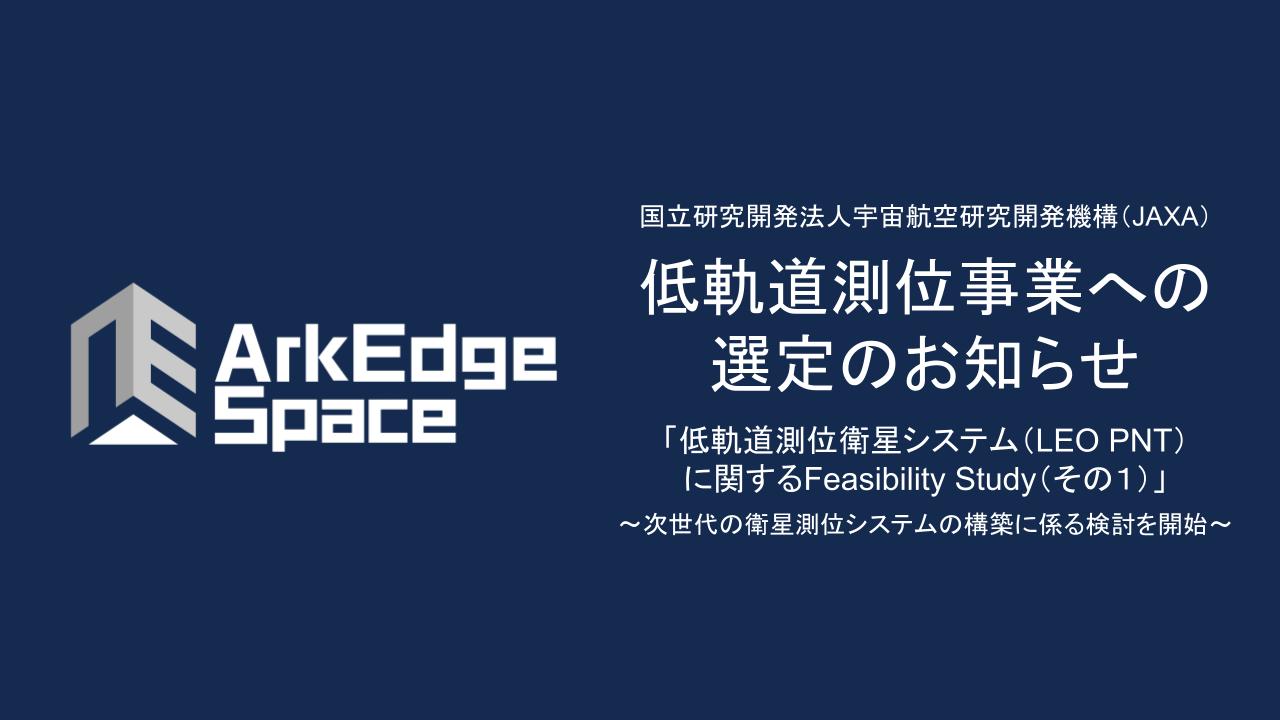ArkEdge Space, a Japanese space start-up based in Tokyo, providing comprehensive solutions from planning and design to mass production and operation of small satellite constellations, has been selected by the Japan Aerospace Exploration Agency (JAXA) as the project provider for the Feasibility Study (Part 1) on the Low Earth Orbit PNT (Position, Navigation, Timing) System (LEO PNT) to be conducted by JAXA. The project commenced on the 11th of October, 2024.
LEO PNT is a constellation of small satellites, orbiting at an altitude of 900-1,200 km. This is lower than the conventional Global Navigation Satellite System (GNSS) orbiting at an altitude of approximately 20,000 km. The system is expected to provide high-precision PNT information worldwide.
LEO PNT’s high-intensity positioning signals are expected to complement the weak signal strength of conventional GNSS signals reaching the Earth’s surface, which are more susceptible to various types of interference, both natural and human-made. The more accurate positioning information provided by LEO PNT is also expected to be used in many other fields, such as autonomous driving.
Project overview
Name: Feasibility Study on Low Earth Orbit PNT System (LEO PNT) (Part 1)
Project description: This project will conduct the following feasibility studies on LEO PNT, which provides PNT services to users on the ground from LEO.
- Evaluation of trade-offs in both satellite constellation and platform design.
- Evaluation of high accuracy orbit determination and time synchronization solutions.
- Evaluation of signal formats and frequency bands used for positioning signals.
- Conceptual design of a LEO PNT demonstration mission, including mission concept proposal, satellite design and orbit design.
Project period: October 2024 – March 2025
Reference URL: https://stage.tksc.jaxa.jp/compe/zui/zuikaku/FY2024-0199.pdf
Main features of LEO PNT High Intensity
LEO PNT operates at a low altitude from the Earth’s surface, enabling the delivery of high-intensity PNT information. LEO PNT is resilient to signal attenuation and interference, so more reliable positioning information is expected to be available.
High Intensity
LEO PNT operates at a low altitude from the Earth’s surface, enabling the delivery of high-intensity PNT information. LEO PNT is resilient to signal attenuation and interference, so more reliable positioning information is expected to be available.

High Accuracy
LEO PNT can provide high accuracy positioning quicker than traditional GNSS. This is possible because of faster line-of-sight vector changes between the receiver on Earth and the satellite. It is expected to be used for new positioning services that will contribute to the next generation of autonomy, including automotive, agriculture and mobile location service sectors.

Global
LEO PNT satellites will be deployed in global orbits, enabling new positioning services for the world. It is also expected to expand the coverage area of services currently based on GEO satellites, such as MADOCA-PPP from the Japanese QZSS.

Expectations for Growth in Geospatial Markets
According to the 2024 European Union Space Agency Market Report, the GNSS-related market will grow 2.2 times to €582 billion over the next 10 years, with the majority coming from ‘service use’.
The road and transport, agriculture and urban development sectors are expected to see particularly strong growth, while the market related to high-precision positioning (advanced automation), where the strengths of LEO PNT can be exploited, is also expected to grow at a similar rate.
Related ArkEdge Space Initiatives – Study of the Lunar Navigation Satellite System (LNSS)
and Lunar Navigation Demonstration Mission
ArkEdge Space, in collaboration with JAXA, is carrying out research and development of positioning and communication services around the Moon, with the aim of establishing a new communications and PNT infrastructure for lunar activities under the Strategic Programme for the Acceleration of Space Exploration and Utilisation (Stardust Programme), which began in 2021. We have been developing the Lunar Navigation Satellite System (LNSS) to contribute to the future lunar economy and ecosystem.
Presently, with the increase in lunar activities such as the ARTEMIS programme, the living and economic sphere of mankind is expanding to the Moon’s surface, and a budding lunar industry is soon to be established. Activities such as rover travel and base construction on the Moon’s surface requires basic infrastructure of PNT and communications, just as on Earth. LunaNet, an international framework for lunar communications and positioning, is being studied by NASA, ESA and JAXA, and the concept of building a GNSS-like positioning satellite system on the Moon is being promoted internationally in collaboration with other countries.
The Lunar GNSS lunar positioning service is called LANS (Lunar Augmented Navigation Service), and the Japanese Lunar Navigation Satellite System (LNSS) will constitute one of its satellite nodes. It will deliver an Augmented Forward Signal (AFS), which will be standardized by LunaNet, to the Moon together with European and US positioning satellites. This will enable users on the Moon to enjoy highly accurate lunar positioning services from the early stages of infrastructure development. The LNSS satellites themselves also need to determine their own position and time, and studies are currently underway in Japan to determine the position and time of LNSS using leaked GNSS signals from Earth. Also, a LNSS demonstration mission to demonstrate these technologies are also under consideration.
LNSS will use the same technology as the selected LEO PNT, broadcasting positioning signals based on orbit and time determination from terrestrial GNSS. ArkEdge Space will promote initiatives related to LEO PNT by utilizing the advanced technology and knowledge gained from these preceding related projects.
Conceptual diagram of the Lunar Navigation Satellite System (LNSS) Demonstration Mission
の概念図.jpg)

